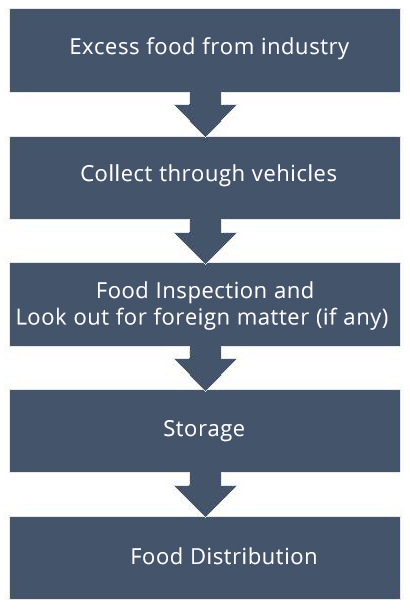Recover Agency

Process:
Inspection Of Food :
Food recovered /collected should be inspected thoroughly before collection. One must ensure that there are no:
- Rips, tears, punctures, holes b. Insect damage
- Rodent damage
- Spill or stains from unknown contaminant e. Label damage
Packaged products must provide all these necessary information for ensuring safety and traceability as per the FSSAI requirements, such as:
- Product name
- Ingredients declared with allergens
- Best Before Date /expiry date /use by date
- Source of food
Check Point: Look out for any extraneous matter /adulterant in food, if found remove them and ensure food is safe for consumption.
Transportation and Food Loading:
Food should be stored in containers suitable for transportation. Containers should be:
- Rigid and sectioned so that foods do not mix.
- Tightly closed to retain the proper food temperature.
- Non-porous to avoid leakage.
- Easy-to-clean or disposable.
- Veg and Non Veg Foods must be separated.
Vehicle Inspection before Unloading and Checking Deliveries:
All incoming vehicles should be inspected and ensure:
- Floorboards/Mats are dry and clean
- No evidence of chemical spills, garbage, waste or spoiled foods
- No evidence of Insect and rodent activity
- Bad odor food should be avoided.
- Notify the supervisor of any issues.
- No evidence of Insect and rodent activity
- Bad odor food should be avoided.
- Notify the supervisor of any issues.
Storing Foods:
Refrigerator should be used to store surplus food and it should be cleaned at least once a week to remove stains, ice particles and food particles.
- Temperature in the refrigerator should be maintained around 4oC.
- 3.Mixing old food with new food is not acceptable.
Distribution/Serving Food:
- Train employees on using the procedures in the given SOPs.
- Wash hands before putting on gloves, each time the gloves are changed when changing tasks, and before serving food.
- Serve food in clean food packets or cartons.
Infrastructure:
BUILDINGS AND FACILITIES:
The methods for adequate maintenance of grounds to avoid contamination include:
- Properly storing equipment, removing litter and waste and cutting weeds and grass within the immediate vicinity of the building.
- Operating systems for waste treatment and disposal in an adequate manner.
- Buildings should be suitable in size, construction and design to facilitate maintenance and sanitary operations.
7. SANITARY OPERATIONS
- All food contact surfaces shall be cleaned as frequently as necessary to protect against the contamination of food.
- Sewage disposal shall be made into an adequate sewerage system.
- Hand washing facilities should be adequate and convenient and be furnished with running water at a suitable temperature.